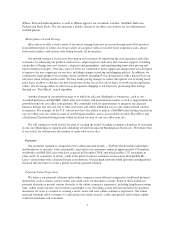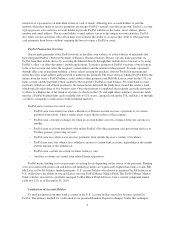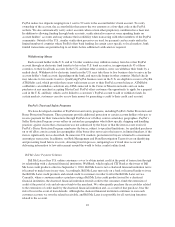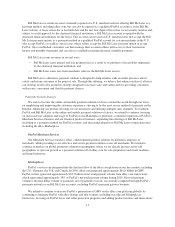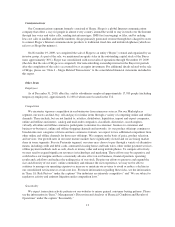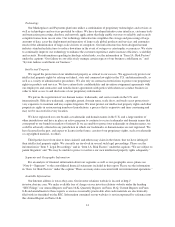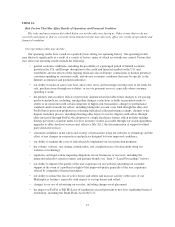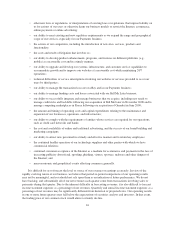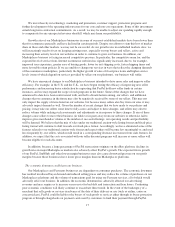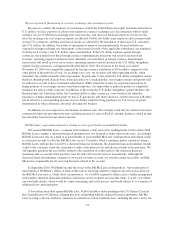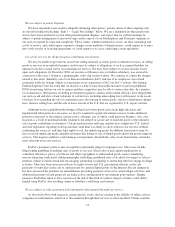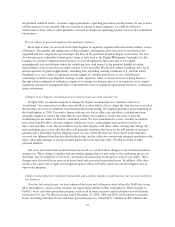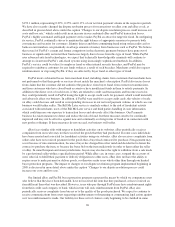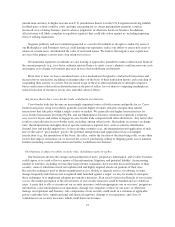eBay 2010 Annual Report Download - page 22
Download and view the complete annual report
Please find page 22 of the 2010 eBay annual report below. You can navigate through the pages in the report by either clicking on the pages listed below, or by using the keyword search tool below to find specific information within the annual report.We invest heavily in technology, marketing and promotion, customer support, protection programs and
further development of the operating infrastructure for our core and non-core operations. Some of this investment
entails long-term contractual commitments. As a result, we may be unable to adjust our spending rapidly enough
to compensate for any unexpected revenue shortfall, which may harm our profitability.
Growth rates of our Marketplaces businesses in some of our most established markets have been slower than
that for ecommerce generally and have declined in certain periods. Despite our efforts to stem this loss of market
share in these and other markets, we may not be successful. As our growth rates in established markets slow, we
will increasingly need to focus on keeping existing users, especially our top buyers and sellers, active and
increasing their activity level on our websites in order to continue to grow our business. In addition, our
Marketplaces business is facing increased competitive pressure. In particular, the competitive norm for, and the
expected level of service from, Internet ecommerce websites has significantly increased, due to, for example,
improved user experience, greater ease of buying goods, lower (or no) shipping costs, faster shipping times and
more favorable return policies. If we are unable to change our services in ways that reflect the changing demands
of the ecommerce marketplace, particularly the higher growth of sales of fixed-price items and higher service
levels (some of which depend on services provided by sellers on our platforms), our business will suffer.
We have announced changes to our Marketplaces business intended to drive more sales and improve seller
efficiency. For example, in the U.S. and the U.K., we have begun testing the efficacy of improving new seller
performance and increasing buyer satisfaction by requesting that PayPal hold new seller funds in certain
instances, and we may expand the scope of such programs in the future. Some of the changes that we have
announced to date have been controversial with, and led to dissatisfaction among, our sellers, and additional
changes that we announce in the future may also be negatively received by some of our sellers. This may not
only impact the supply of items listed on our websites, but because many sellers also buy from our sites, it may
adversely impact demand as well. Given the number of recent changes that we have made to our policies and
pricing, it may take our sellers some time to fully assess and adjust to these changes, and sellers may elect to
reduce volume while making such assessments and adjustments or in response to these changes. If any of these
changes cause sellers to move their business (in whole or in part) away from our websites or otherwise fail to
improve gross merchandise volume or the number of successful listings, our operating results and profitability
will be harmed. We believe that the mix of sales under our traditional auction-style listing format and fixed-price
listing format will continue to shift towards our fixed-price format. Accordingly, we have eliminated some of the
features related to our traditional auction-style format and expect others will become less meaningful to, and used
less frequently by, our sellers, which would result in a corresponding decrease in revenues from such features. In
addition, we expect that the costs associated with our seller discount programs will increase as more sellers will
become eligible for such discounts.
In addition, because a large percentage of PayPal transactions originate on the eBay platform, declines in
growth rates in major Marketplaces markets also adversely affect PayPal’s growth. The expected future growth
of our PayPal, StubHub, and other lower margin businesses may also cause downward pressure on our profit
margins because those businesses have lower gross margins than our Marketplaces platforms.
The economic downturn could harm our business.
Our Marketplaces and Payments businesses are dependent on consumer purchases. The economic downturn
has resulted in reduced buyer demand and reduced selling prices and may reduce the volume of purchases on our
Marketplaces platforms and the volume of transactions paid for using our Payment services, all of which would
adversely affect our business. In addition, the economic downturn has adversely affected our advertising
revenues and may require us to increase our reserves for bad debt and transaction and loan losses. Continuing
poor economic conditions will likely continue or exacerbate these trends. In the event of the bankruptcy of a
merchant that sells goods or services in advance of the date of their delivery or use (such as airline, cruise or
concert tickets), PayPal could be liable to the buyers of such goods or services either through its buyer protection
program or through chargebacks on payment cards used by customers to fund their payment through PayPal.
17


